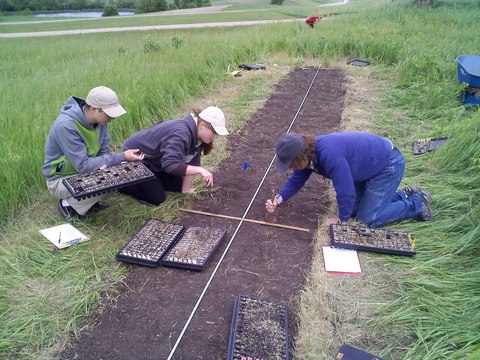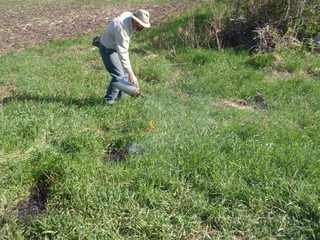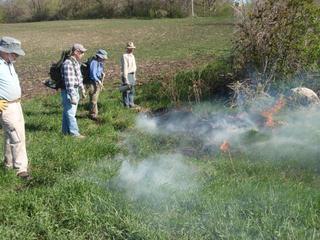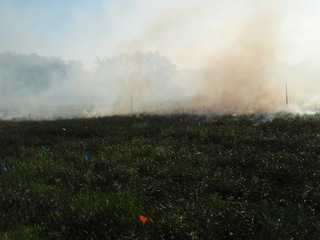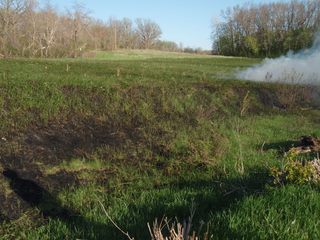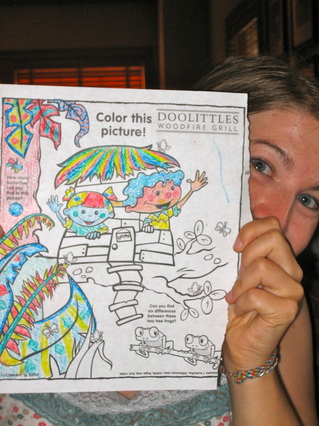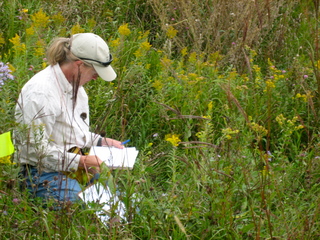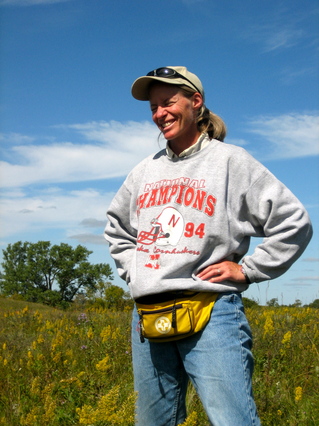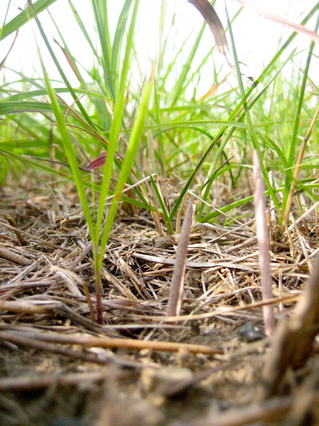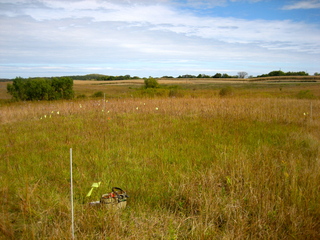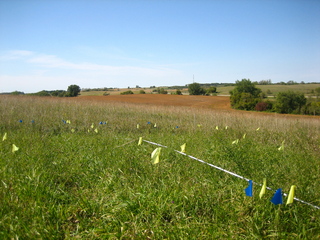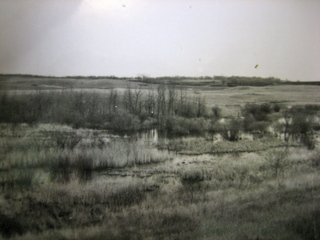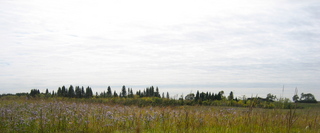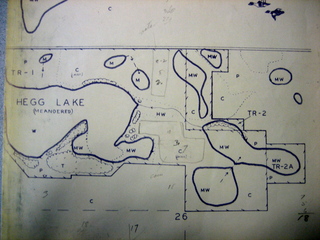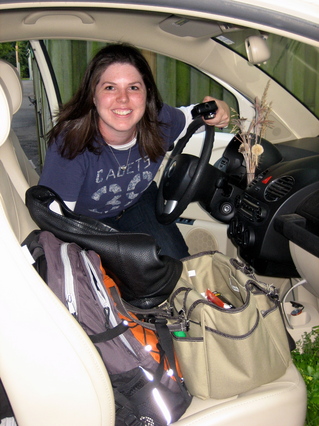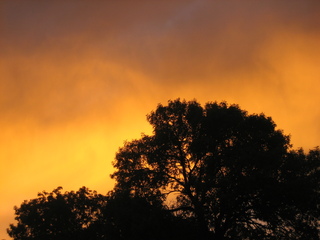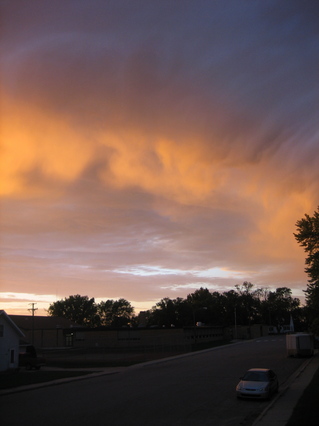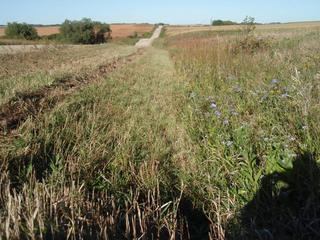|
|
Hi everyone, Maria here again. Today was a particularly happening day in my opinion. Everyone had something to do. Amber E. is back from Alaska with Ruth! Karen arrived from Evanston in the afternoon!
In the morning those of us who hadn’t finished our Stipa searches in the common garden finished that! (So Stipa is done! – we scaled back though and only searched for the 2011(?) cohort). After that Gretel, Ruth, Amber E and I put Position/Row signs in the common garden and made the signs face East/Westwards so now it’s so much easier to read the signs while you are walking in the common garden. Then we got started on looking at the phenology of Echinacea in the common garden. We systematically walked through each row, looking out for flowering Echinacea with emerged anthers and pollen, twist-tying the heads and recording them in our visors. Josh joined us when he finished his Stipa searches. We found quite a few flowering heads – bet there’ll be more soon.
While we were looking for flowering Echinacea, we saw Stuart, Callin, Amber Z and Nicholas crowded around ‘Joe’ – the pet name given to the prominently flowering Echinacea at row 28, position 860. As described by Callin in the previous post, they were practicing bract-painting for their independent projects on Joe.
When we finished looking at all the rows, it was time for lunch and short presentations of our projects. It was good to hear about everyone’s projects and talk about my own projects and get feedback. After lunch, we got started on our independent projects or worked on the New Media Initiative.
Gretel and I headed to Hegg Lake to look for Dichanthelium (Panic Grass) seeds for my second project. This summer I will be collecting seeds from Dichanthelium plants from different remnants, including Hegg Lake and Loettler’s Corner (I might not have spelt that right – sorry). My plan is to collect seeds from 30 individuals from each “site”, as there are several places at Hegg Lake that seem to have a lot of Dichanthelium. After collecting the seeds, I will be bringing them back to Chicago Botanic Garden and do more work on them in the fall/later.
Click here for the
Google doc of my summer project proposals
I am super super indebted/thankful/grateful for Gretel. Without her guidance, I’d probably be in a big mess/not knowing what to do/still be at Hegg Lake as this is my first time doing independent field work.
When we reached the place at Hegg Lake (it was near the road, area with ditch, south of the parking lot), a lot fo the Dichanthelium seeds had already fallen off the culms. It was quite disheartening. We walked a little north and found a patch of Dichanthelium with most of their seeds intact, then we laid out the tape measure for 20m in a roughly north-south direction (I kept thinking it was 2m while Gretel patiently corrected me ^^;;). Initial plan was to do every plant within arm’s length from transect, or every other plant if population was dense. However, that was not quite possible given the circumstances. After Gretel and I collected seed from the first plant and did all the measurements, she continued measuring/collecting while I picked ~30 plants near the transect (more than my arm’s length) that had at least one culm with 8 or more seeds to collect from and flagged them with a blank flag. I started measuring/collecting after I finished flagging. Around 4pm, Lee called – reinforcements were coming! Ruth and Lee arrived with Karen and they helped us finished the rest of the plants (by that time Gretel had completed 17 plants (!!) and I was on my 6th plant). It turned out that we had 31 flags so 31 envelopes with data and samples! We also collected some “random” samples – ie seeds from various random plants away from transect. Finished around 5pm – thanks to Gretel, Lee, Ruth and Karen! Really excited to get the first 30 done!
Take a look at the simple data entry for today’s collection for more technical details if you’re interested. I might also do the seed count for today’s samples just to see how many seeds we can get from 30 plants using the ‘8 or more’ rule. (I just need to be rreally careful not to lose any seed >.<)
Dichant_DE-HL1001-31.xlsx
We left 11 flags (labelled with sample number) at the site that we will return to later to collect more seeds from.
Now that I have more experience, I’ll definitely be more systematic+efficient about it.
Notes to self for tomorrow/next time:
– “just-in-case” extras (extra equipment, envelopes, pens, sharpies, flags) do come in handy! Meter sticks are probably more efficient than tape measures. More flags would be good. Maybe use a different color for “done” or for extras.
– Extra samples are good too. Maybe do 32 plants per site?
– Bring a plastic bag/something to put a plant specimen in – I need to get a sample of the other Dichanthelium species (“hairy leaved”) to press and identify.
– Equipment list would be useful esp when I have more than 5 things to remember.
Lesson of the Day: Having an experienced person around and helpers is always always always helpful! =D
Thanks again to Gretel and everyone who helped!
Team Echinacea got a lot done this past week. On Monday we finished seedling searches, and on Wednesday we finished recruitment surveys. We’ve also made a lot of progress with the New Media Initiative: We now have a Facebook page and a Twitter account.
Then on Thursday, we started stipa searches. We looked in the Common Garden experimental plot for stipa that were planted as seed in the past two years. This means we were looking through bunches of grass to find this one specific kind of grass, which posed quite a challenge. As Stuart put it, it’s like looking for a needle in a needlestack. But we persevered! We found quite a few stipa plants, and will continue searching this week.
We also began aphid searching, as Katherine mentioned. I was glad that I didn’t find too many aphid infestations on our lovely Echinacea plants. It was a very satisfying way to end the work week.
Over the weekend, we had a 4th of July potluck-picnic celebration at Elk Lake. The food was all so delicious! And a construction team directed by Per made a formidable sandcastle fortress. Below are some pictures that Maria took. Happy (belated) 4th everyone!



This week was much less strenuous than the last, thanks to a bout of rainy weather. Monday we took advantage of a dry day to conduct seedling searches and re-flag the common garden. Tuesday and Wednesday were too soggy for field work, so we stayed inside to work on independent projects and the new media initiative. Things finally dried up by Thursday afternoon, much to the relief of the antsier among us. That afternoon we learned how to conduct seedling recruitment surveys. These surveys are part of a long-term study to assess how Echinacea populations establish and persist in restorations (see Wagenius et al. 2011). Friday we conducted seedling searches at several sites (Landfill, NW of Townhall, and Staffanson Prairie Reserve) and planted seedlings at Staffanson.
That about brings us up to date, workwise. On Saturday we took a trip to Alexandria and enjoyed the wonders of the Runestone Museum. Callin took some delightful photos that he will share here shortly.
Hey everyone, I’m Maria, making my first appearance on the flog. I’m from Malaysia, currently a sophomore/rising junior at Northwestern. Sorry for the late first post as I’ve been unable to get onto the flog until yesterday 🙂
I’m now sitting beside Amy Dykstra out on the porch of Hjellm house enjoying the scenery while freezing in the cold. We have not been able to go out to do field work since Tuesday afternoon(?) due to wet weather, but we’re going to go out and plant the remaining <20 seedlings at Staffanson after lunch and perhaps seedling searches. Hope that the ground dries up!
Anyway, here’s the link to the googledoc of my summer project proposal. I’m constantly updating it/working on it so it seems most practical to share it as a googledoc. Any input will be highly appreciated 😀 Hope that everyone will be able to assess the link. Let me know if the link is not working! Thanks!
*Update June 24: The googledoc link is updated. Everyone should be able to assess it now 🙂
I was nervous when I entered the idyllic enclave of Kensington, MN. Here I was, after five days of driving from San Francisco, launching myself into a new place with new people, without knowing what to expect. I’m pleased to say that I am happy with my decision to join team Echinacea. On Monday, June 12th we began planting seedlings in Staffanson prairie reserve. This was part of a study on how burning plots affects the next generation of plants. Amazingly, we managed to finish the entire plot on Tuesday, thanks to the efficient cooperation of eleven people. Wednesday was too rainy for field work, so we spent the morning cleaning up and organizing our materials. After lunch we took a field trip to visit various sites and explore the flora therein (Josh snapped some wonderful pictures and will post them here soon). Over Thursday and Friday we completed seedling searches in three remnants: RI, KJ, and NESS. At each site we flagged a subset of Echinacea plants and pairs of team members searched for seedlings around each plant, mapping their results so we can find them again in the future.
This week has also brought a lot of discussion. Prominent items on the agenda were chores (someone has to keep the field station clean), summer research projects, and our new media initiative. In addition to helping out with ongoing field projects, each member of the team must tackle a research question–working in groups or individually, depending on their preferences. Project proposals should appear on the flog over the next few days. I’m excited to see what people come up with. We talked at length about how we can use various media sources (the flog, the website, facebook, Twitter) to enhance communication within the Echinacea Project and with a wider community. I never thought a field biology internship would include making a Twitter account, but now I’m convinced it’s a good idea. Check the flog for our plans and ideas.
Lastly, and most importantly, this weekend marks Kensington’s annual celebration of Runestone Day, which means Viking shiploads of small town fun. Last night we saw a fireworks show paired with a lightning storm (I’m not sure which was more impressive) and this morning several of us ran in the Kensington Runestone 5K. Stay tuned for pictures.
Cheers,
Katherine
Hey, it’s Josh again (I’m back! I’ll have a reintroduction post soon). We’ve had quite the productive week while Stuart was back in Chicagoland. With the help of awesome folks like Nicholas, Amber, and Callin, my garden is all dug up, weeded, planted, and watered. Now we wait (and water).
We also took care of the seedling searches at EELR, NWLf, and NNWLf, not to mention extending the lines of the Staffanson common garden to 100m and marking them.
Hey look, some planting!

Yesterday we burned the common garden. There was a lot of fuel, since the common garden was last burned in May 2008. It was a slow, even burn.

Stuart lighting the fire, at the northeast corner of the common garden.
Click on the thumbnail image to see a larger picture.

Second photo: We doused the back fire with water, allowing the head fire to proceed west-ward across the common garden.

Third photo: View from the northeast, looking southwest. The dark green in the foreground has already burned.

Fourth photo: View from the northwest. It was a good burn!
Wow! This month has just flown by! It’s hard to believe that September is almost over, and so many things have happened.
Let me explain. No. It’s too much. Let me sum up:
Josh and Hillary had their last day on the 3rd. But before they left we: visited the county fair and saw lot’s of farm animals, visited Morris, and went out to a restaurant for dinner where Hillary created some beautiful art (see picture below). I think she has a great future in the creative arts.

After they left, Amy and I worked very hard on seedling rechecks. Unfortunately, the weather was not always in our favor, but we persevered:


I also spent a significant amount of time gathering my final data for both my seedlings and plugs:

I finished my last bit of measuring on the 14th.
Runestone:

Hegg Lake:

Bob Mahoney’s:

Bob Mahoney’s site has a ton of spiders. I’m not usually very squeamish, but these guys are huge!

So as you all know (I hope), I planted both plugs and seeds at three locations in Kensington: Hegg Lake, Runestone, and Bob Mahoney’s. One of the goals that I had for the summer was to find out what I could about these three locations. The site history; what they were planted with and how they were managed. After I finished my final data collection, I was finally able to take some time away to focus on these questions. I visited the Wildlife Management Office (Runestone) in Fergus Falls and the Department of Natural Resources (Hegg Lake) office in Glenwood.
In Fergus, I met with Kevin Brennan and Chad Raitz, who were both very knowledgeable and helpful. I learned that the Runestone site is old farmland that was purchased in 1988. It was planted with corn in 1989, and with soy in 1990 and 1991, before being seeded with natives. The warm season grass seeds were harvested from a number of sites within a 50mi radius of Runestone, but the cool season grasses were purchased.
Apparently, the gov’t offices can usually harvest their own warm season grasses, but have a harder time with cool season grasses because 1) their harder to find and 2) they don’t have the manpower off-season to go collect the seed. I also learned that in general, they don’t usually plant forbs, or rather they don’t go out and harvest forbs specifically. They do bulk harvests at prairie remnants and previous restorations and if they get forb seed that’s great, but they don’t go out specifically to gather forb seed. This makes me wonder about how successful a prairie restoration can be if the entire community assemblage isn’t present. How often do they go to harvest, what species are they missing? etc. Chad also told me that some of their harvesting sites are now being invaded with Tansy and parsnip, and so they can’t use those sites anymore. But he didn’t think they were working to fend off the invasion, again he sited lack of manpower.
Kevin Kotts at the DNR was also very helpful. He pulled out all of the files on the Hegg Lake site and let me wade through them. I learned a lot about the DNR, their management practices, and a bit about the politics involved in creating a wildlife refuge like Hegg.
It turns out that the DNR’s purchase of the Hegg Lake site was quite controversial. The land was purchased in two parts, but the bulk of it was sold by Mel Hagen for $12,500 back in 1961. Another smaller section was purchased in 1962 from a Mrs. Viola Brown. However, before the land could be purchased, the sale had to be approved by the Douglas County Commissioners, and it wasn’t. Much of the land at Hegg was in crop production, and thus was on the tax lists, and the commissioners didn’t want to loose productive land to wetland restoration. One commissioner claimed that Douglas County already had “enough ducks”! John Scharf, the Area Game Manager for the DNR, had to work for a solid year to get the purchase approved. He wrote in one of his many letters that, “their narrow-minded approach left [him] in a foul mood.” (Pun intended?)
Once they had the land, the DNR focused more on restoring the wetlands than the upland prairie areas at Hegg. Much of the site actually remained cropland for years after the initial purchase. The area where my site was located was finally restored in 1998 and planted with native seed harvested in the Fergus Falls area, at least that’s what Kevin thinks. Despite all their files on the subject, there wasn’t any firm paperwork on the actual restoration of that portion of Hegg.
Nevertheless, I got took some interesting pictures and found out some interesting information about the site.
Hegg in 1970’s

Hegg Today:

Hegg Map:

On September 17th, I was able to drive into Minneapolis-St.Paul to visit the University of Minnesota one last time. I met with a number of really interesting professors there. University of MN definitely has a great faculty and some very interesting programs! After my meetings, I met Amanda (from 2009 crew) for dinner. It was great to catch up with her and also to discuss the pollinator study we’ve both been working on for over a year now. We will get this project published by hook or by crook! That night Amy let me crash at her place before driving back to Kensington. I finally met Brad! I felt like I knew the man, but I’d never actually met him. I also met Mr. Bird, and let me tell you, that was an honor! Mr. Bird is quite the personality. So, THANK YOU AMY AND BRAD for letting me spend the night!
On September 20th I drove back to Chicago! I was surprised to find temperatures in the 80s here in Chicago, when I had been, slowly, getting used to temperatures in the 50’s and 60’s up in MN. Here’s my car all packed for the way home:


Two last pictures of a beautiful MN sunset:


Thus ends a very successful field season!
Kate and I have had some beautiful weather for field work (except today–it rained most of the day). Here’s a picture of the roadside site we call East Riley. Notice that our ambitious mower has mowed TWO swaths of the roadside. The mowed area includes most of the circles I am searching to re-find and measure plants we had identified in years past.

We do seedling searches every spring at 14 prairie remnants. We search within 41 cm (or 50 cm for smaller populations) of randomly selected Echinacea plants that flowered the previous summer. Since 2006 we have used these spring searches to find new seedlings (identifiable by the presence of cotyledons). When we find seedlings, we draw circle maps showing the seedling locations with respect to the focal plant, and make measurements to other tagged plants. In 2009 and 2010 we mapped ALL Echinacea plants within the 41/50-cm radius circles. Late in the growing season, we return to the 14 sites and re-find the seedlings and other plants. We update the circle maps, and measure the surviving plants.
Why go to all this trouble? I plan to use the data to estimate the growth rate for these small Echinacea populations. Are the Echinacea producing enough offspring to maintain their populations? That’s the question I hope to answer!
The re-finds are complete at eelr, lih, nessman, nwlf, randt, sap, sgc and spp. I am currently working at eri; still remaining are eth, kj’s, lc, lf and ri. Some of the sites are disappointing. There has been a lot of gopher activity at lih, and most of the Echinacea plants, big and small, are gone. I was only able to find 1 of the 12 seedlings we had previously mapped. Other sites (eri, ri, nessman) are disturbed by frequent roadside mowing and scraping. In spite of that, we were able to find 18 of the 23 previously identified seedlings at nessman. In total (so far), we have found 54/85 seedlings. Some of the survivors were first identified in 2007 (I don’t think I’ve found any 2006 seedlings yet–but there weren’t many to begin with).
I’ll post an update when I finish entering all the data…or the next time I get rained out!
1) Hillary came back, now Lauren has the other half of her brain.
2) Echinacea Team Basket Ball
3) Kate was a dinner plate for a dragonfly eating a black fly. Kinda gross, but cool.
4) Vally Fair. Josh now likes roller-coasters. Mission Accomplished.
5) Ruth Visited. Josh made cookies to celebrate.
6) Swim after work on Monday. (In our clothes… it was just that hot)
7) Finished measuring all of Kate’s seedlings. They live! Mwahaha!
|
|




